octane CHEVROLET ASTRO 2003 Owners Manual
[x] Cancel search | Manufacturer: CHEVROLET, Model Year: 2003, Model line: ASTRO, Model: CHEVROLET ASTRO 2003Pages: 386, PDF Size: 17.31 MB
Page 157 of 386
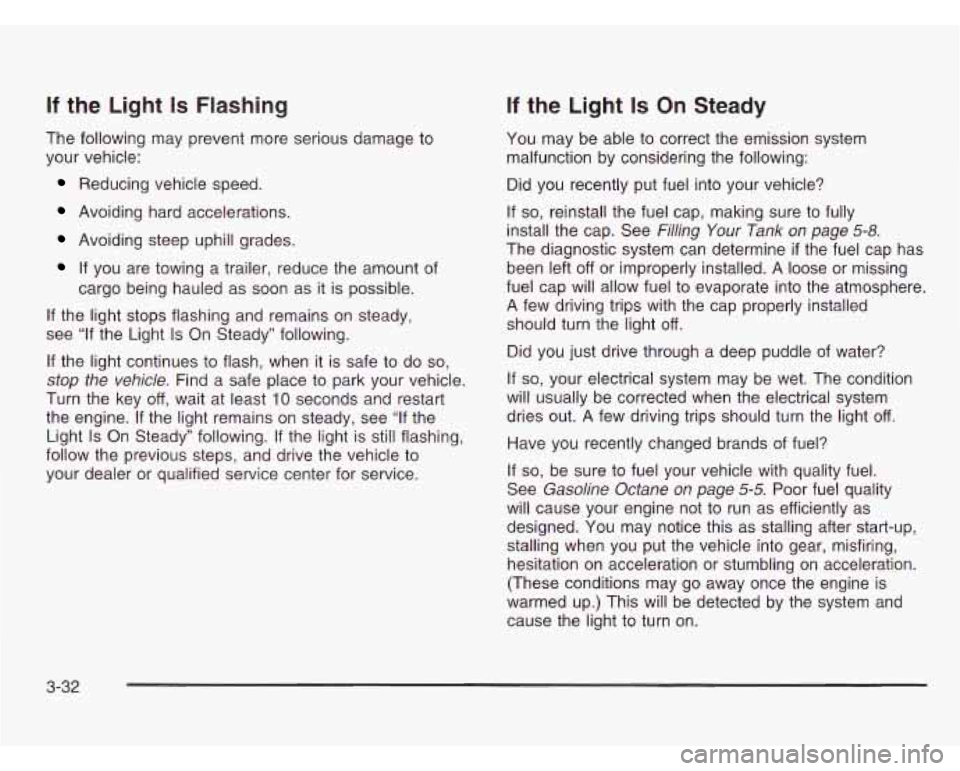
If the Light Is Flashing
The following may prevent more serious damage to
your vehicle:
Reducing vehicle speed.
Avoiding hard accelerations.
Avoiding steep uphill grades.
If you are towing a trailer, reduce the amount of
cargo being hauled as soon as it is possible.
If the light stops flashing and remains on steady,
see
“If the Light Is On Steady” following.
If the light continues to flash, when it is safe to do so,
stop the vehicle. Find a safe place to park your vehicle.
Turn the key off, wait at least
10 seconds and restart
the engine.
If the light remains on steady, see “If the
Light
Is On Steady” following. If the light is still flashing,
follow the previous steps, and drive the vehicle to
your dealer or qualified service center for service.
If the Light Is On Steady
You may be able to correct the emission system
malfunction by considering the following:
Did you recently put fuel into your vehicle?
If so, reinstall the fuel cap, making sure to fully
install the cap. See
Filling Your Tank on page 5-8.
The diagnostic system can determine if the fuel cap has
been left off or improperly installed. A loose or missing
fuel cap will allow fuel to evaporate into the atmosphere.
A few driving trips with the cap properly installed
should turn the light off.
Did you just drive through a deep puddle of water?
If
so, your electrical system may be wet. The condition
will usually be corrected when the electrical system
dries out.
A few driving trips should turn the light off.
Have you recently changed brands of fuel?
If
so, be sure to fuel your vehicle with quality fuel.
See
Gasoline Octane on page 5-5. Poor fuel quality
will cause your engine not to run as efficiently as
designed. You may notice this as stalling after start-up,
stalling when you put the vehicle into gear, misfiring,
hesitation on acceleration or stumbling on acceleration.
(These conditions may go away once the engine is
warmed up.) This will be detected by the system and
cause the light to turn on.
3-32
Page 218 of 386
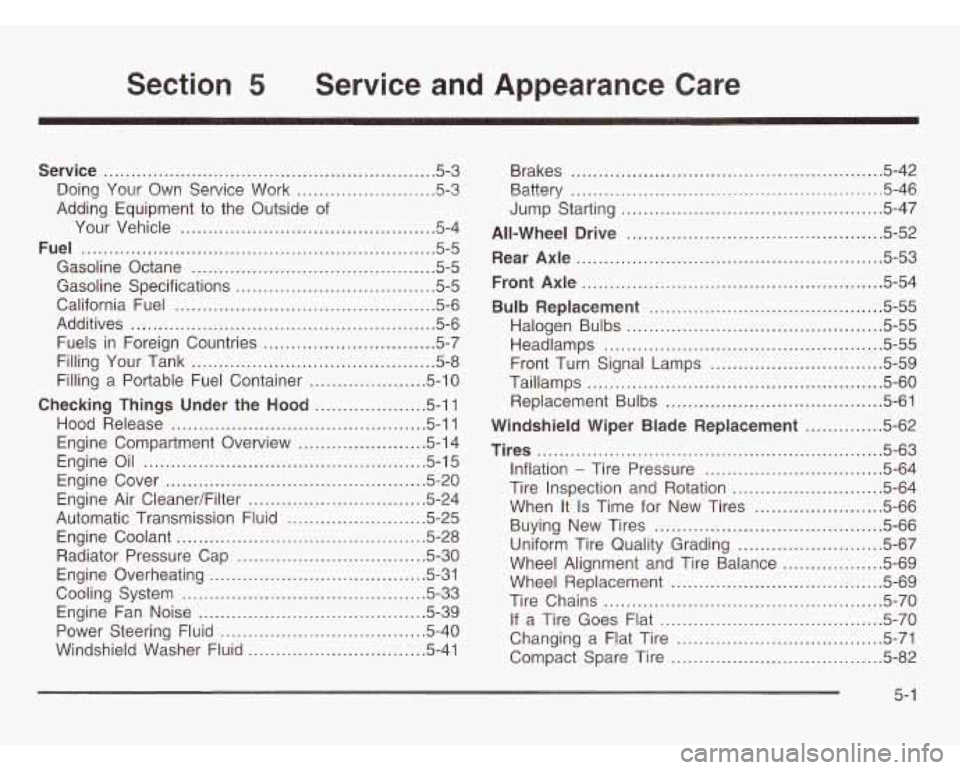
Section 5 Service and Appearance Care
Service .......................................................... -5-3
Doing Your Own Service Work
......................... 5-3
Adding Equipment to the Outside of
Your Vehicle
.............................................. 5-4
Fuel ................................................................ 5.5
Gasoline Octane ........................................... -5-5
Gasoline Specifications .................................... 5.5
California Fuel ............................................. -56
Additives
....................................................... 5.6
Fuels in Foreign Countries
............................... 5.7
Filling Your Tank
............................................ 5-8
Filling a Portable Fuel Container
..................... 5-10
Checking Things Under the Hood .................... 5-1 1
Hood Release .............................................. 5.11
Engine Compartment Overview
...................... 5.14
Engine Oil
................................................... 5.15
Engine Cover ................. .... ........ 5.20
Engine Air Cleaner/Filter
................. ........ 5.24
Automatic Transmission Fluid
...................... 5.25
Engine Coolant ............................................. 5.28
Radiator Pressure Cap
.................................. 5.30
Engine Overheating
....................................... 5.31
Cooling System
............................................ 5.33
Engine Fan Noise
......................................... 5.39
Power Steering Fluid
..................................... 5.40
Windshield Washer Fluid
................................ 5.41 Brakes
........................................................ 5.42
Battery
........................................................ 5-46
Jump Starting
............................................... 5-47
All-Wheel Drive .............................................. 5-52
Rear Axle ....................................................... 5-53
Front Axle ...................................................... 5-54
Bulb Replacement .......................................... 5-55
Halogen Bulbs .............................. ..... 5-55
Headlamps .................................. ..... 5-55
Front Turn Signal Lamps ............................... 5-59
Replacement Bulbs
....................................... 5-61
Windshield Wiper Blade Replacement .............. 5-62
Tires .............................................................. 5.63
Inflation
- Tire Pressure ................................ 5-64
Tire Inspection and Rotation
........................... 5-64
When It
Is Time for New Tires ....................... 5-66
Buying New Tires
......................................... 5-66
Uniform Tire Quality Grading
.......................... 5-67
Wheel Alignment and Tire Balance
.................. 5-69
Wheel Replacement
...................................... 5-69
Tire Chains
.................................................. 5-70
If a Tire Goes Flat ........................................ 5.70
Changing a Flat Tire ..................................... 5.71
Compact Spare Tire ...................................... 5-82
Taillamps
.................................................... 5-60
5- 1
Page 222 of 386
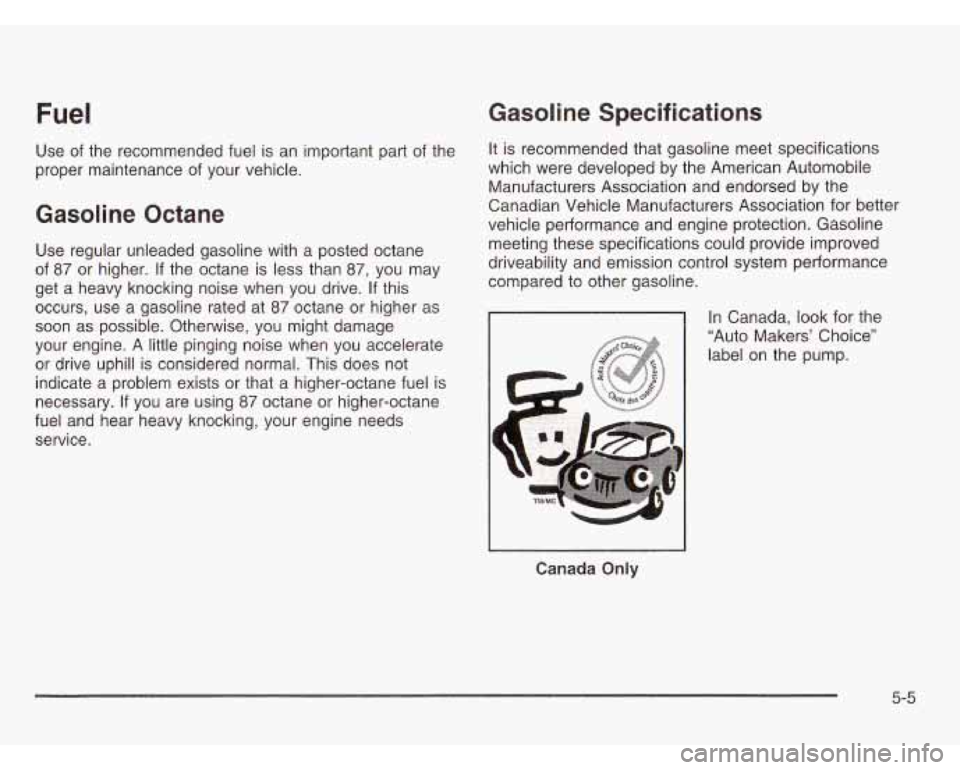
Fuel
Use of the recommended fuel is an important part of the
proper maintenance of your vehicle.
Gasoline Octane
Use regular unleaded gasoline with a posted octane
of
87 or higher. If the octane is less than 87, you may
get a heavy knocking noise when you drive. If this
occurs, use a gasoline rated at
87 octane or higher as
soon as possible. Otherwise, you might damage
your engine. A little pinging noise when you accelerate
or drive uphill is considered normal. This does not
indicate a problem exists or that a higher-octane fuel is
necessary.
If you are using 87 octane or higher-octane
fuel and hear heavy knocking, your engine needs
service.
Gasoline Specifications
It is recommended that gasoline meet specifications
which were developed by the American Automobile
Manufacturers Association and endorsed by the
Canadian Vehicle Manufacturers Association for better
vehicle performance and engine protection. Gasoline
meeting these specifications could provide improved
driveability and emission control system performance
compared to other gasoline.
In Canada, look for the
“Auto Makers’ Choice’’
label on the pump.
Canada Only
5-5
Page 224 of 386
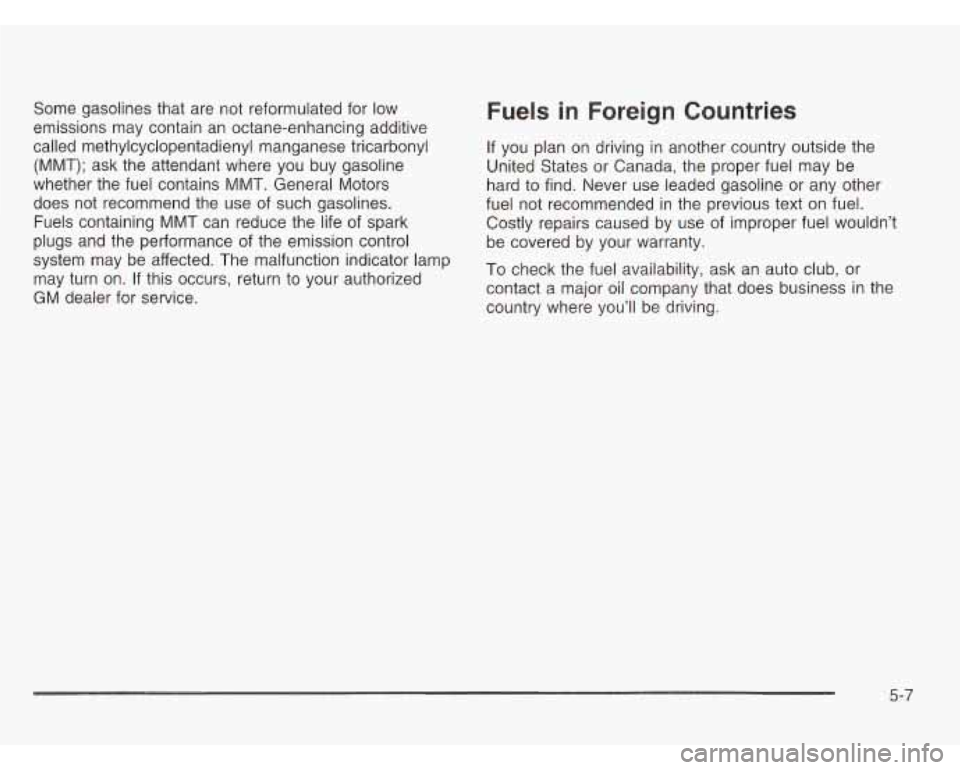
Some gasolines that are not reformulated for low
emissions may contain an octane-enhancing additive
called methylcyclopentadienyl manganese tricarbonyl
(MMT); ask the attendant where you buy gasoline
whether the fuel contains MMT. General Motors
does not recommend the use of such gasolines.
Fuels containing MMT can reduce the life of spark
plugs and the performance
of the emission control
system may be affected. The malfunction indicator lamp
may turn on.
If this occurs, return to your authorized
GM dealer for service.
Fuels in Foreign Countries
If you plan on driving in another country outside the
United States or Canada, the proper fuel may be
hard to find. Never use leaded gasoiine or any other
fuel not recommended in the previous text on fuel.
Costly repairs caused by use of improper fuel wouldn’t
be covered by your warranty.
To check the fuel availability, ask an auto club, or
contact a major oil company that does business in the
country where you’ll be driving.
5-7
Page 323 of 386
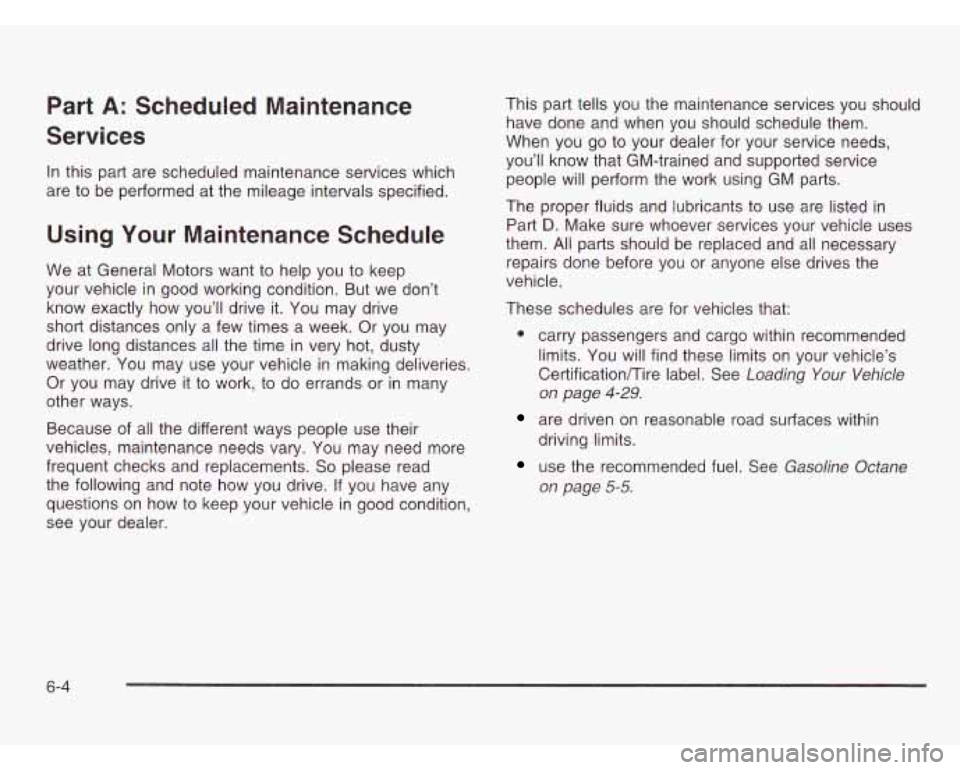
Part A: Scheduled Maintenance
Services
In this part are scheduled maintenance services which
are to be performed at the mileage intervals specified.
Using Your Maintenance Schedule
We at General Motors want to help you to keep
your vehicle in good working condition. But we don’t
know exactly how you’ll drive it. You may drive
short distances only a few times a week. Or you may
drive long distances all the time in very hot, dusty
weather. You may use your vehicle in making deliveries.
Or you may drive it to work, to do errands or in many
other ways.
Because of all the different ways people use their
vehicles, maintenance needs vary. You may need more
frequent checks and replacements.
So please read
the following and note how you drive.
If you have any
questions on how to keep your vehicle in good condition,
see your dealer. This part tells
you the maintenance services you should
have done and when you should schedule them.
When you go to your dealer for your service needs,
you’ll know that GM-trained and supported sewice
people will perform the work using GM parts.
The proper fluids and lubricants to use are listed in
Part D. Make sure whoever services your vehicle uses
them.
All parts should be replaced and all necessary
repairs done before you or anyone else drives the
vehicle.
These schedules are for vehicles that:
carry passengers and cargo within recommended
limits. You will find these limits on your vehicle’s
CertificationRire label. See
Loading Your Vehicle
on page
4-29.
are driven on reasonable road surfaces within
driving limits.
use the recommended fuel. See Gasoline Octane
on page
5-5.
6-4
Page 372 of 386
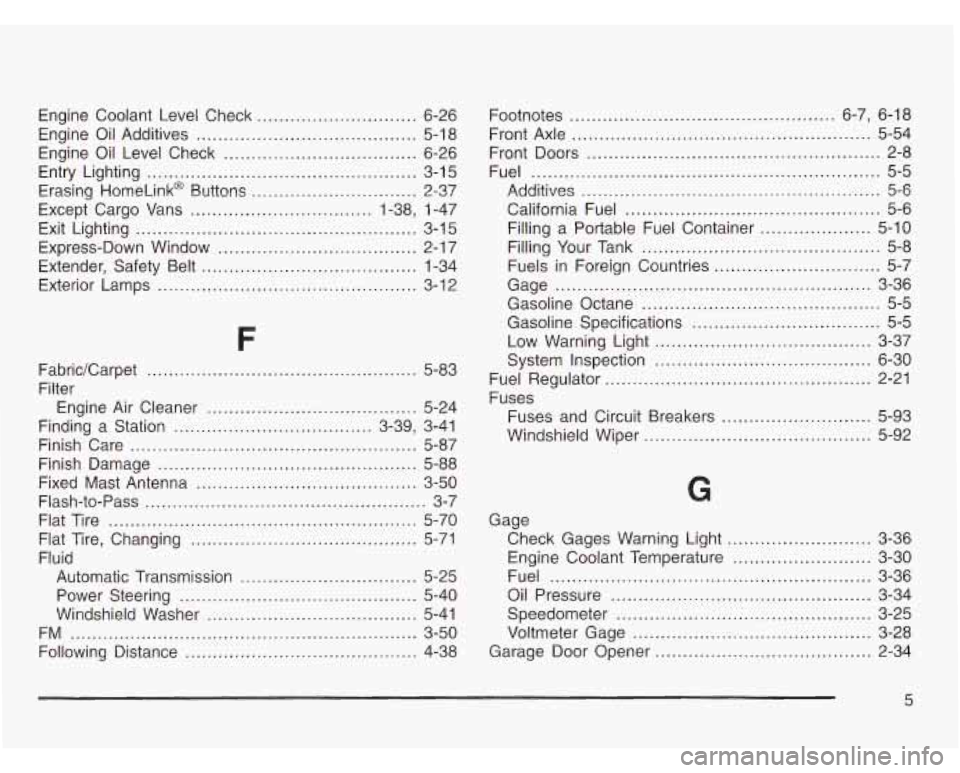
Engine Coolant Level Check ............................. 6-26
Engine Oil Additives
........................................ 5-18
Entry Lighting
................................................. 3-15
Erasing HomeLink@ Buttons
.............................. 2-37
Except Cargo Vans
................................. 1-38, 1-47
Express-Down Window
.................................... 2-1 7
Extender, Safety Belt
....................................... 1-34
Exterior Lamps
............................................... 3-12
Engine
Oil Level Check
................................... 6-26
Exit Lighting
................................................... 3-15
F
FabricKarpet ................................................. 5-83
Filter Engine Air Cleaner
...................................... 5-24
Finding a Station
.................................... 3-39, 3-41
Finish Care
.................................................... 5-87
Finish Damage
............................................... 5-88
Fixed Mast Antenna
........................................ 3-50
Flash-to-Pass
................. ........................... 3-7
Flat Tire
........................................................ 5-70
Fluid Flat Tire, Changing
......................................... 5-71
Automatic Transmission
................................ 5-25
Power Steering
........................................... 5-40
Windshield Washer
...................................... 5-41
FM
............................................................... 3-50
Following Distance
.......................................... 4-38 Footnotes
..... ................................ 6.7.
6-18
Front Axle
........ ................................... 5-54
Front Doors
..................................................... 2-8
Fuel
............................................................... 5-5
Additives ...................................................... 5-6
California Fuel
.............................................. 5-6
Filling a Portable Fuel Container
.................... 5-10
Filling Your Tank
........................................... 5-8
Fuels in Foreign Countries
.............................. 5-7
Gage
......................................................... 3-36
Gasoline Octane
........................................... 5-5
Gasoline Specifications .................................. 5-5
System Inspection
....................................... 6-30
Fuel Regulator
................................................ 2-21
Fuses Low Warning
Light
....................................... 3-37
Fuses and Circuit Breakers
........................... 5-93
Windshield Wiper
......................................... 5-92
G
Gage
Check Gages Warning Light
.......................... 3-36
Engine Coolant Temperature
......................... 3-30
Fuel
.......................................................... 3-36
Oil Pressure
............................................... 3-34
Speedometer
.............................................. 3-25
Voltmeter Gage
........................................... 3-28
Garage Door Opener
....................................... 2-34
5
Page 373 of 386
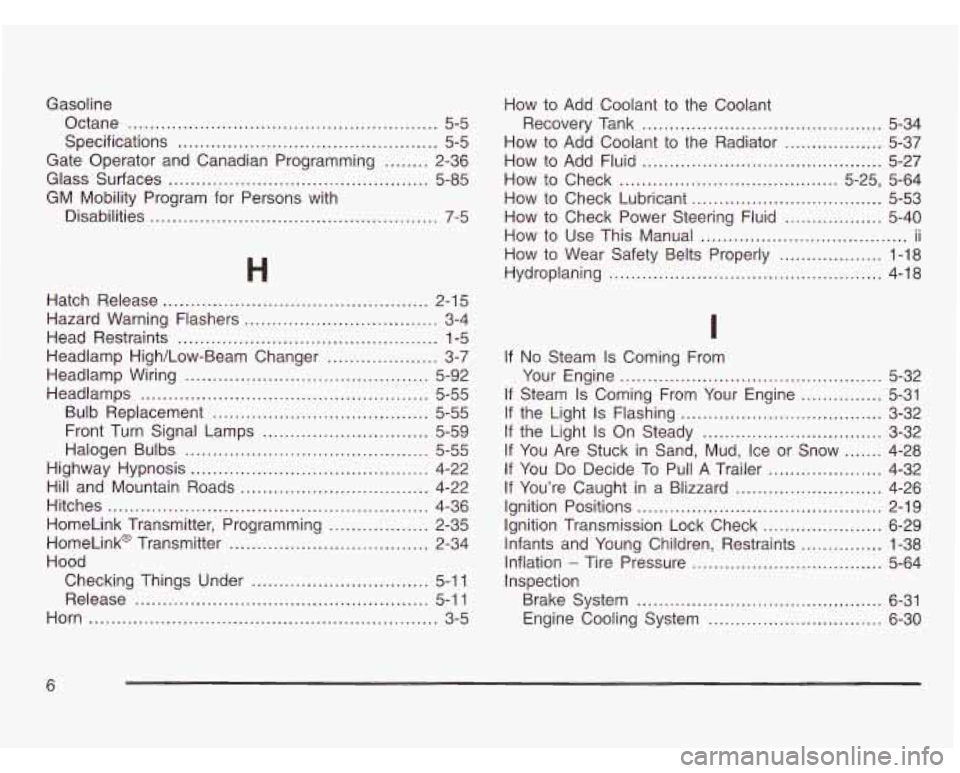
Gasoline Octane
........................................................ 5-5
Specifications
............................................... 5-5
Gate Operator and Canadian Programming
........ 2-36
Glass Surfaces
............................................... 5-85
GM Mobility Program for Persons with
Disabilities
.................................................... 7-5
Hatch R
H
e I' ease ......................... ........ 2-15
Hazard Warning Flashers
............................... 3-4
Head Restraints
............................................... 1-5
Headlamp High/Low-Beam Changer
.................... 3-7
Headlamp Wiring
............................................ 5-92
Headlamps
.................................................... 5-55
Bulb Replacement
.................................... 5-55
Front Turn Signal Lamps
.................. ..... 5-59
Halogen Bulbs
............................ ........ 5-55
Highway Hypnosis
........................................... 4-22
Hill and Mountain Roads
.................................. 4-22
Hitches
.......................................................... 4-36
HomeLink Transmitter, Programming
.................. 2-35
HomeLink@ Transmitter
.................................... 2-34
Hood Checking Things Under
................................ 5-1 1
Release
..................................................... 5-1 1
Horn
............................................................... 3-5 How
to Add Coolant to the Coolant
How to Add Coolant to the Radiator
.................. 5-37
How to Add Fluid
............................................ 5-27
How to Check
........................................ 5-25, 5-64
How to Check Lubricant
................................... 5-53
How to Check Power Steering Fluid
.................. 5-40
How to Use This Manual
...................................... ii
Recovery Tank ........................................ 5-34
How to Wear Safety Belts Properly
................... 1-18
Hydroplaning
.................................................. 4-18
I
If No Steam Is Coming From
Your Engine
............................................ 5-32
If Steam Is Coming From Your Engine ........... 5-31
If the Light
Is Flashing ..................................... 3-32
If the Light
Is On Steady ................................. 3-32
If You Are Stuck in Sand, Mud, Ice or Snow
....... 4-28
If You Do Decide
To Pull A Trailer ..................... 4-32
If You're Caught in a Blizzard ........................... 4-26
Ignition Transmission Lock Check
...................... 6-29
Infants and Young Children, Restraints
............... 1-38
Inflation
- Tire Pressure ................................... 5-64
Inspection Brake System
............................................. 6-31
Engine Cooling System
................................ 6-30
Ignition Positions
............................................. 2-19
6